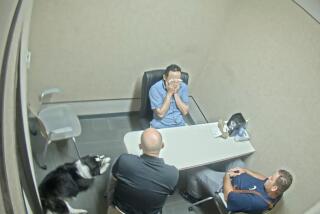Reporter Held Captive Is Dead, Videotape Shows
- Share via
WASHINGTON — Terrorism claimed another U.S. victim Thursday when a videotape recovered in Pakistan showed that Wall Street Journal reporter Daniel Pearl had been killed by his captors.
Colleagues said the gruesome video indicated that Pearl was executed shortly after several U.S. newspapers received e-mail photographs in late January showing the journalist in chains and with a pistol to his head. The e-mails came from a group of self-described Pakistani nationalists.
Pearl, 38, was abducted in the Pakistani port city of Karachi on Jan. 23 while investigating local ties between alleged “shoe bomber” Richard C. Reid and Osama bin Laden’s Al Qaeda terrorist network.
An intense investigation by Pakistani officials, backed by the FBI and the CIA, had raised hopes as recently as this week that Pearl would be rescued or released unharmed. But officials said the videotape showed Pearl’s throat being cut several weeks ago.
“It’s pretty awful, and I hope no one ever sees it who hasn’t had to see it already,” said a Journal editor familiar with the tape.
Paul Steiger, the Journal’s managing editor, announced the news to the paper’s Washington bureau about 4 p.m. Thursday. In response to questions, Steiger refused to say whether Pearl had been tortured but said his body would not be returned to the United States. Pakistani officials said separately that Pearl’s body had not been recovered.
“Lots of people were crying,” one Journal reporter said. “Danny had a lot of friends here.”
The State Department expressed outrage at Pearl’s death. “Both the United States and Pakistan are committed to identifying all the perpetrators of this crime and bringing them to justice,” spokesman Richard Boucher said.
In Beijing, a somber President Bush expressed condolences to Pearl’s family and warned that such “criminal barbaric acts” only stiffen America’s resolve to “rid the world” of terrorism.
“We are really sad for his wife and parents, and his friends and colleagues, who have been clinging to hope for weeks that he would be found alive,” Bush said.
Bush said he was “especially sad” for the couple’s unborn child, “who will now know his father through the memory of others.”
Pearl’s French-born wife, Mariane, is seven months pregnant with their first child. She had remained in Karachi and made several emotional appeals to her husband’s captors after he disappeared. Colleagues said she planned to fly home today to her family in Paris.
“We are heartbroken by his death,” Peter Kann, publisher of the Journal, said in a statement. “Danny was an outstanding colleague, a great reporter and a dear friend of many at the Journal.”
Kann said Pearl’s “murder is an act of barbarism that makes a mockery of everything Danny’s kidnappers claimed to believe in. They claimed to be Pakistani nationalists, but their actions must surely bring shame to all true Pakistani patriots.”
A family spokesman, Gary Foster, told reporters outside Pearl’s parents’ home in Encino that his “senseless murder lies beyond our comprehension.”
He described Pearl as “a musician, a writer, a storyteller and a bridge-builder.”
Steven Goldstein, a spokesman for Dow Jones & Co., which publishes the Journal, said Pearl’s family was setting up a foundation to support charities focusing on causes “that Danny has dedicated his life to.”
He said contributions could be sent to the Daniel Pearl Family Foundation, care of the Wall Street Journal, P.O. Box 300, Princeton, NJ 08543.
Born in Princeton, N.J., Pearl graduated from Birmingham High School in Van Nuys and Stanford University. He joined the Journal 12 years ago, working in the paper’s Atlanta and Washington bureaus before being assigned to London and then Paris. He moved in 2000 to Bombay, India, as the paper’s South Asia bureau chief.
Case Cast Shadow on Pakistani Leader’s Visit
He disappeared in Karachi after he apparently was lured into a trap by his abductors, who used false identities and Internet accounts to hide their tracks.
His case partly overshadowed the visit to Washington last week of Pakistani President Pervez Musharraf. Bush and Musharraf discussed the case, and two Journal editors met privately with the Pakistani leader to plead for his assistance.
Brig. Mukhtar Ahmed, home secretary of Sindh province, where Karachi is located, said a videotape was received by the U.S. Consulate in Karachi about 11 p.m. there Thursday. Ahmed said the video “contained scenes of Mr. Pearl’s captivity and scenes of his murder.”
In Islamabad, the Pakistani capital, U.S. Embassy spokesman Mark Wentworth would not comment on the contents of the tape other than to say “the evidence provided is conclusive.”
Until Thursday, Pakistani officials and Journal editors proceeded as if Pearl were alive even though his kidnappers had not directly communicated since sending the two e-mails Jan. 27 and Jan. 28. The first message included a photograph showing Pearl holding up a Karachi newspaper dated Jan. 24.
The group demanded, among other things, the immediate release of Pakistani prisoners who had been captured in Afghanistan and are being interrogated at the U.S. naval base at Guantanamo Bay, Cuba.
Pakistani authorities repeatedly announced that they were about to break the case. But several later e-mails proved to be hoaxes, and U.S. investigators privately voiced growing doubts as days turned to weeks without additional word from Pearl’s captors.
Last week, those doubts became public when the chief suspect in the case, a British-born Muslim militant named Ahmad Omar Saeed Sheikh, told a Pakistani judge that “from what I understand, he [Pearl] is dead.”
Sheikh, whose story reportedly changed several times during his interrogation, also allegedly told investigators that he had telephoned Pearl’s captors Feb. 5 and they then told him in code language that Pearl was dead. Sheikh later claimed that the reporter had been killed in an escape attempt around Jan. 31, but investigators said they didn’t believe that account.
Sheikh told a court hearing that he had engineered Pearl’s abduction to protest Pakistan’s close support for the United States in the war on terrorism after the Sept. 11 attacks. “Our country shouldn’t be catering to America’s needs,” Sheikh said.
3 Other Suspects Charged in Kidnapping
Pakistani authorities have charged three other suspects with helping Sheikh send the two e-mail messages and photographs that confirmed Pearl’s kidnapping.
The kidnappers initially claimed that Pearl was a CIA agent. A day later, however, they said they had decided that he worked for Israeli intelligence. The Journal, and both governments, vehemently denied that Pearl was anything but a journalist.
One suspect, Fahad Naseem, told a Pakistani judge Thursday that Sheikh had told him that he wanted to seize someone who is “anti-Islam and a Jew.”
The tape was sent just as Pakistan and the rest of the Muslim world began the celebration of Eid al-Adha, which marks the end of the hajj, or pilgrimage to the holy city of Mecca.
Additional suspects who allegedly were involved in setting up the false meeting that led to Pearl’s kidnapping and death are still being sought. All are believed to be members of radical Islamic groups.
Sheikh has boasted that he was involved in several terrorist attacks in India, including an assault last December on the Parliament in New Delhi.
*
Drogin reported from Washington and Mohan from Islamabad. Staff writers Doyle McManus, Greg Miller and Faye Fiore in Washington and Edwin Chen in Beijing contributed to this report.
*
RELATED STORY
Profile: Pearl had an eye and ear for the unconventional. A10
More to Read
Sign up for Essential California
The most important California stories and recommendations in your inbox every morning.
You may occasionally receive promotional content from the Los Angeles Times.












